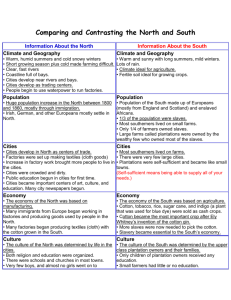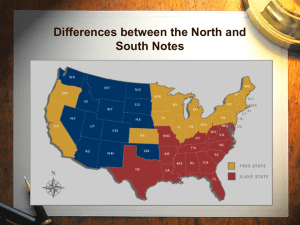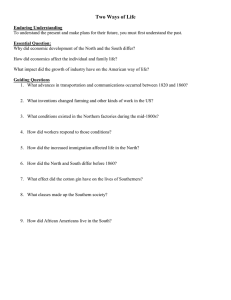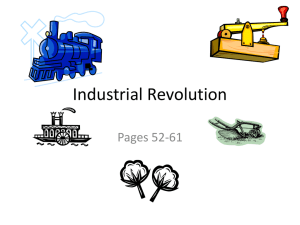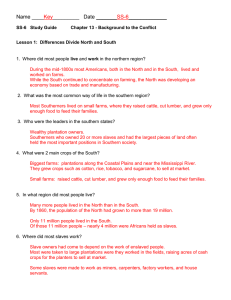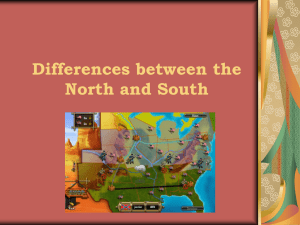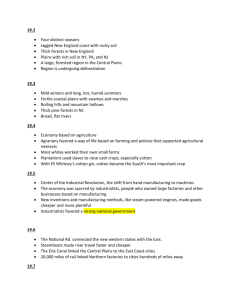Comparing and Contrasting the North and South
advertisement
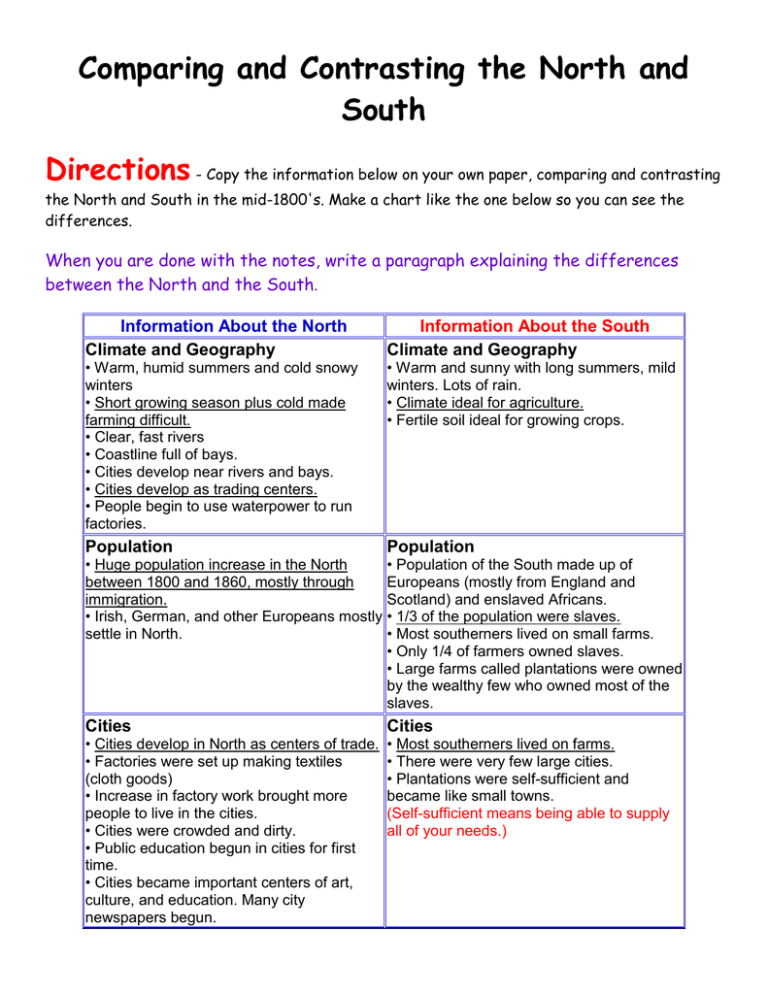
Comparing and Contrasting the North and South Directions - Copy the information below on your own paper, comparing and contrasting the North and South in the mid-1800's. Make a chart like the one below so you can see the differences. When you are done with the notes, write a paragraph explaining the differences between the North and the South. Information About the North Climate and Geography Information About the South Climate and Geography • Warm, humid summers and cold snowy winters • Short growing season plus cold made farming difficult. • Clear, fast rivers • Coastline full of bays. • Cities develop near rivers and bays. • Cities develop as trading centers. • People begin to use waterpower to run factories. • Warm and sunny with long summers, mild winters. Lots of rain. • Climate ideal for agriculture. • Fertile soil ideal for growing crops. Population Population • Huge population increase in the North • Population of the South made up of between 1800 and 1860, mostly through Europeans (mostly from England and immigration. Scotland) and enslaved Africans. • Irish, German, and other Europeans mostly • 1/3 of the population were slaves. settle in North. • Most southerners lived on small farms. • Only 1/4 of farmers owned slaves. • Large farms called plantations were owned by the wealthy few who owned most of the slaves. Cities Cities • Cities develop in North as centers of trade. • Factories were set up making textiles (cloth goods) • Increase in factory work brought more people to live in the cities. • Cities were crowded and dirty. • Public education begun in cities for first time. • Cities became important centers of art, culture, and education. Many city newspapers begun. • Most southerners lived on farms. • There were very few large cities. • Plantations were self-sufficient and became like small towns. (Self-sufficient means being able to supply all of your needs.) Economy Economy • The economy of the North was based on manufacturing. • Many immigrants from Europe began working in factories and producing goods used by people in the North. • Many factories began producing textiles (cloth) with the cotton grown in the South. • The economy of the South was based on agriculture. • Cotton, tobacco, rice, sugar cane, and indigo (a plant that was used for blue dye) were sold as cash crops. • Cotton became the most important crop after Ely Whitney’s invention of the cotton gin. • More slaves were now needed to pick the cotton. • Slavery became essential to the South’s economy. Culture Culture • The culture of the North was determined by life in the cities. • Both religion and education were organized. • There were schools and churches in most towns. • Very few boys, and almost no girls went on to secondary school. • College was reserved for the wealthy. • The culture of the South was determined by the upper class plantation owners and their families. • Only children of plantation owners received any education. • Small farmers had little or no education. • The culture of the South revolved around plantation life. Transportation Transportation • Canals were mostly in the North. • The Erie Canal was a huge success. • Most of the railroads were in the North. • 30,000 miles of track was laid by 1850. • Canals and railroads allowed northern businesses to grow. • The South was still dependent on the steamship. • Railroads existed, but far less than in the North. Directions: *Step 1: Identify the Evidence Jobs – Time Keeper, Note Taker Review the chart with your group. Have a 10 minute discussion about what similarities and differences you see between the North and the South. Make sure your note keeper is writing down your thoughts. *Step 2: Organize the Evidence Jobs: Writer, Reader Create a color coded venn diagram on your chart paper that will allow you organize your thoughts regarding the similarities and differences between the North and the South. Ex: North (red) South (blue) Both (green) *Step 3: Interpret the Evidence Jobs: Think, Think, Think Explain the differences that you think were leading factors to the start of the Civil War.
